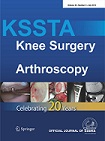
ARTHROPLASTY
No advantage of patient-specific instrumentation over conventional instruments in UKA
This report has been verified
by one or more authors of the
original publication.
Knee Surg Sports Traumatol Arthrosc. 2018 Jun;26(6):1662-1670
55 patients scheduled for an Oxford unicompartmental knee arthroplasty were randomized to either patient-specific instrumentation use or conventional instrumentation use for surgery. Patients were assessed for radiographic outcome at 6 weeks postoperatively, while clinical outcome on the Oxford Knee Score was assessed at 12 months postoperatively. Results demonstrated no significant differences between groups in the incidence of tibial or femoral outlying components in either coronal or sagittal alignment. OKS scores also did not significantly differ between groups at 12 months.
Unlock the full ACE Report
You have access to {0} free articles per month.Click below to unlock and view this {1}
Unlock NowCritical appraisals of the latest, high-impact randomized controlled trials and systematic reviews in orthopaedics
Access to OrthoEvidence podcast content, including collaborations with the Journal of Bone and Joint Surgery, interviews with internationally recognized surgeons, and roundtable discussions on orthopaedic news and topics
Subscription to The Pulse, a twice-weekly evidence-based newsletter designed to help you make better clinical decisions
Exclusive access to original content articles, including in-house systematic reviews, and articles on health research methods and hot orthopaedic topics
Or upgrade today and gain access to all OrthoEvidence content for just $1.99 per week.
Already have an account? Log in


Subscribe to "The Pulse"
Evidence-Based Orthopaedics direct to your inbox.
{0} of {1} free articles
Become an OrthoEvidence Premium Member. Expand your perspective with high-quality evidence.
Upgrade Now













































































